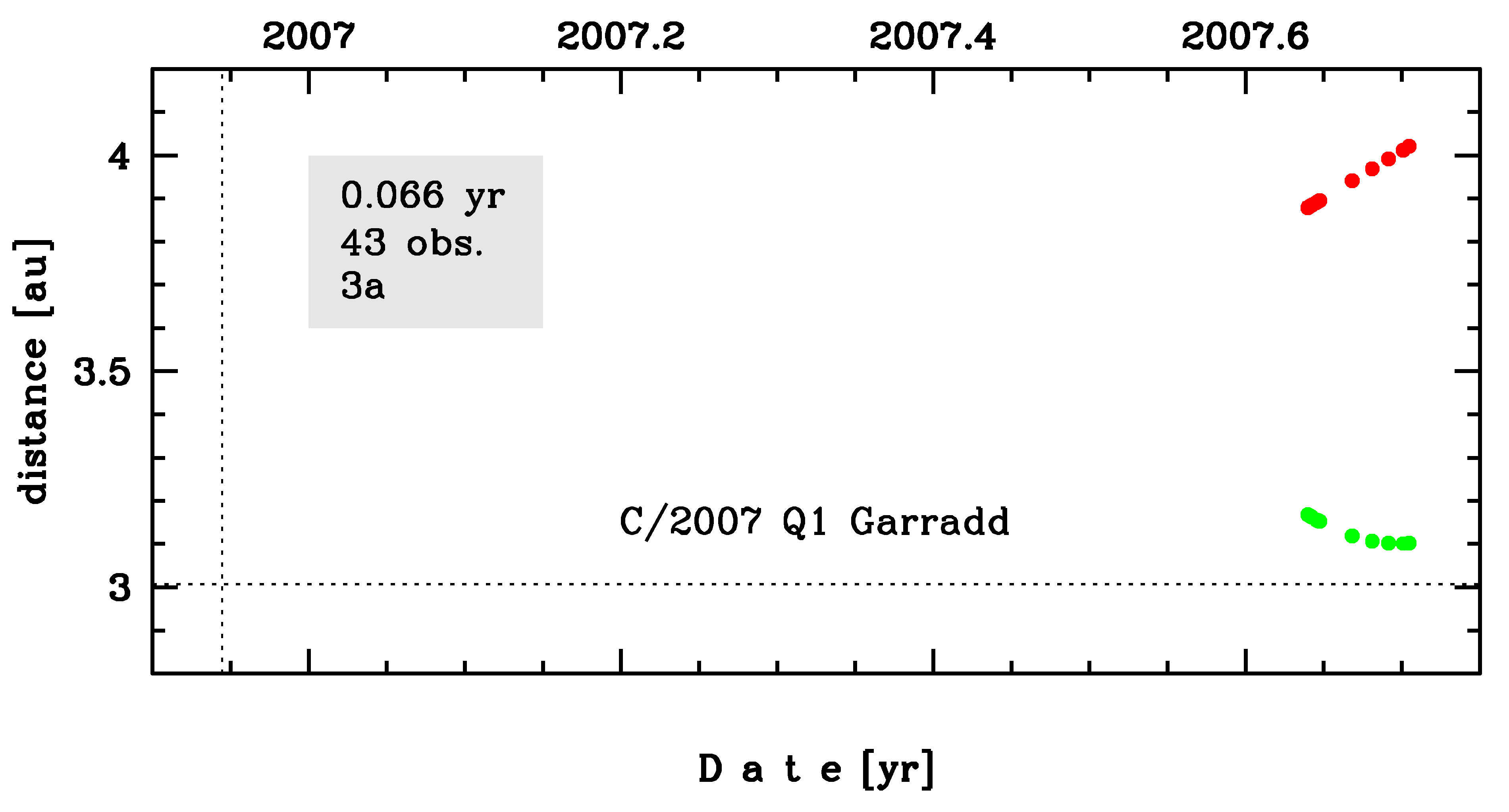C/2007 Q1 Garradd
more info
Comet C/2007 Q1 was discovered on 21 August 2007 by G. J. Garradd (Siding Spring Survey), that is about eight months after perihelion passage (q=3.017 au) and observed only about three weeks in the narrow range of heliocentric distance from 3.88 au to 4.02 au (very poor quality orbit).
Comet had its closest approach to the Earth on 11 September 2007 (3.093 au), about 3 weeks after its discovery and about 9 months after its perihelion passage.
This probably Oort spike comet suffers moderate planetary perturbations during its passage through the planetary system and these perturbations lead to escape the comet from the solar system on hyperbolic orbit (see future barycentric orbit).
See also Królikowska and Dybczyński 2013 and Królikowska 2020.
Comet had its closest approach to the Earth on 11 September 2007 (3.093 au), about 3 weeks after its discovery and about 9 months after its perihelion passage.
This probably Oort spike comet suffers moderate planetary perturbations during its passage through the planetary system and these perturbations lead to escape the comet from the solar system on hyperbolic orbit (see future barycentric orbit).
See also Królikowska and Dybczyński 2013 and Królikowska 2020.
| solution description | ||
|---|---|---|
| number of observations | 43 | |
| data interval | 2007 08 21 – 2007 09 14 | |
| data type | observed only after perihelion (POST) | |
| data arc selection | entire data set (STD) | |
| range of heliocentric distances | 3.88 au – 4.02au | |
| detectability of NG effects in the comet's motion | NG effects not determinable | |
| type of model of motion | GR - gravitational orbit | |
| data weighting | NO | |
| number of residuals | 84 | |
| RMS [arcseconds] | 0.58 | |
| orbit quality class | 3a | |
| previous orbit statistics, both Galactic and stellar perturbations were taken into account | ||
|---|---|---|
| no. of returning VCs in the swarm | 2620 | * |
| no. of escaping VCs in the swarm | 2381 | |
| no. of hyperbolas among escaping VCs in the swarm | 2323 | |
| previous reciprocal semi-major axis [10-6 au-1] | -977.78 – 60.47 – 1,054.89 | |
| previous perihelion distance [au] | 2.982 – 3.005 – 3.125 | R |
| previous aphelion distance [103 au] | 1.5 – 3.6 – 21 | |
| time interval to previous perihelion [Myr] | 0.021 – 0.075 – 0.74 | R |
| percentage of VCs with qprev < 10 | 96 | |
| percentage of VCs with qprev > 20 | 4 | |
| previous_g orbit statistics, here only the Galactic tide has been included | ||
|---|---|---|
| no. of returning VCs in the swarm | 2630 | * |
| no. of escaping VCs in the swarm | 2371 | |
| no. of hyperbolas among escaping VCs in the swarm | 2323 | |
| previous reciprocal semi-major axis [10-6 au-1] | -977.72 – 60.47 – 1,054.88 | |
| previous perihelion distance [au] | 2.982 – 3.005 – 3.162 | R |
| previous aphelion distance [103 au] | 1.5 – 3.6 – 21 | |
| time interval to previous perihelion [Myr] | 0.021 – 0.075 – 0.78 | R |
| percentage of VCs with qprev < 10 | 97 | |
| percentage of VCs with 10 < qprev < 20 | 1 | |
| percentage of VCs with qprev > 20 | 2 | |
